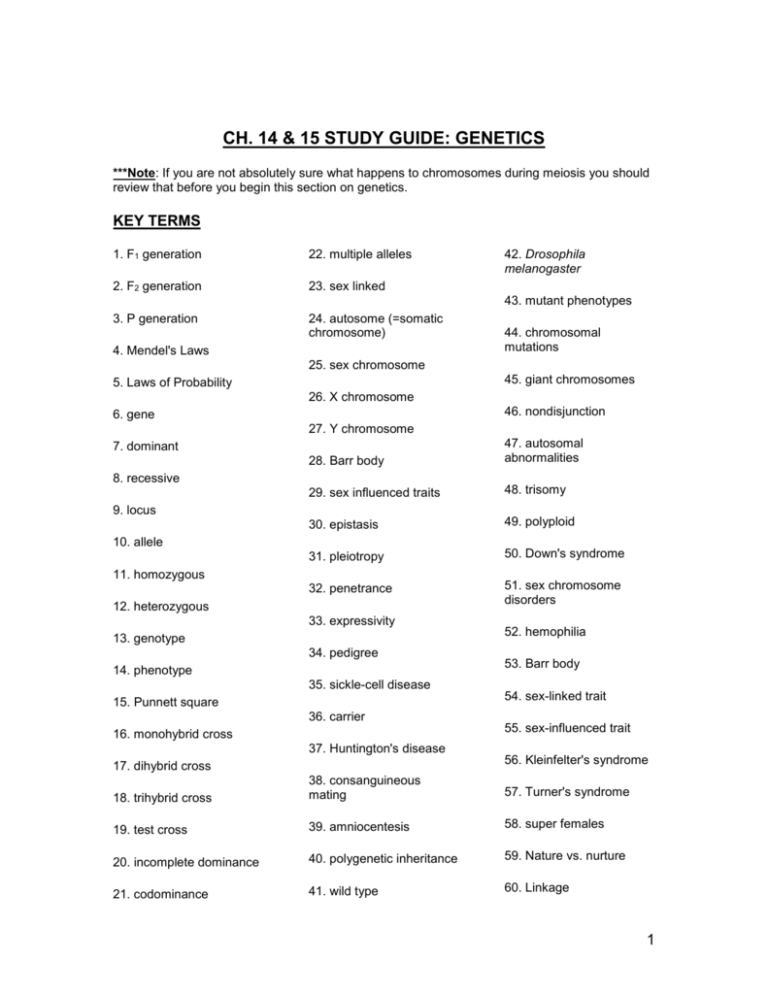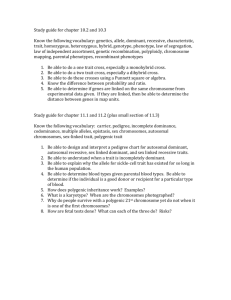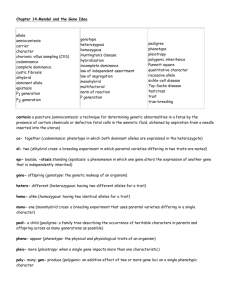ch. 14 & 15 study guide: genetics
advertisement

CH. 14 & 15 STUDY GUIDE: GENETICS ***Note: If you are not absolutely sure what happens to chromosomes during meiosis you should review that before you begin this section on genetics. KEY TERMS 1. F1 generation 22. multiple alleles 2. F2 generation 23. sex linked 42. Drosophila melanogaster 43. mutant phenotypes 3. P generation 24. autosome (=somatic chromosome) 4. Mendel's Laws 44. chromosomal mutations 25. sex chromosome 45. giant chromosomes 5. Laws of Probability 26. X chromosome 46. nondisjunction 6. gene 27. Y chromosome 28. Barr body 47. autosomal abnormalities 29. sex influenced traits 48. trisomy 30. epistasis 49. polyploid 31. pleiotropy 50. Down's syndrome 32. penetrance 51. sex chromosome disorders 7. dominant 8. recessive 9. locus 10. allele 11. homozygous 12. heterozygous 33. expressivity 13. genotype 34. pedigree 14. phenotype 35. sickle-cell disease 15. Punnett square 36. carrier 16. monohybrid cross 37. Huntington's disease 17. dihybrid cross 52. hemophilia 53. Barr body 54. sex-linked trait 55. sex-influenced trait 56. Kleinfelter's syndrome 18. trihybrid cross 38. consanguineous mating 57. Turner's syndrome 19. test cross 39. amniocentesis 58. super females 20. incomplete dominance 40. polygenetic inheritance 59. Nature vs. nurture 21. codominance 41. wild type 60. Linkage 1 WORD ROOTS co - = together (codominance: phenotype in which both dominant alleles are expressed in the heterozygote) - centesis = a puncture (amniocentesis: a technique for determining genetic abnormalities in a fetus by the presence of certain chemicals or defective fetal cells in the amniotic fluid, obtained by aspiration from a needle inserted into the uterus) di - = two (dihybrid cross: a breeding experiment in which parental varieties differing in two traits are mated) epi - = beside; - stasis = standing (epistasis: a phenomenon in which one gene alters the expression of another gene that is independently inherited) geno - = offspring (genotype: the genetic make up of an organism) hetero - = different (heterozygous: having two different alleles for a trait) homo - = alike (homozygous: having two identical alleles for a trait) pedi - = a child (pedigree: a family tree describing the occurrence of heritable characters in parents and offspring across as many generations as possible) pheno - = appear (phenotype: the physical and physiological traits of an organism) pleio - = more (pleiotropy: when a single gene impacts more than one characteristic) poly - = many; gene - = produce (polygenic: an additive effect of two or more gene loci on a single phenotypic character) aneu - = without (aneuploidy: a chromosomal aberration in which certain chromosomes are present in extra copies or are deficient in number) cyto - = cell (cytological maps: charts of chromosomes that locate genes with respect to chromosomal features) hemo - = blood (hemophiliac: a human genetic disease caused by a sex-linked recessive allele, characterized by excessive bleeding following injury) mono - = one (monosomic: a chromosomal condition in which a particular cell has only one copy of a chromosome, instead of the normal two; the cell is said to be monosomic for that chromosome) non - = not; dis - = separate (nondisjunction: an accident of meiosis, in which both members of a pair of homologous chromosomes or both sister chromatids fail to move apart properly) poly - = many (polyploidy: a chromosomal alteration in which the organism possesses more than two complete chromosome sets) re - = again; com - = together; bin - = two at a time (recombinant: an offspring whose phenotype differs from that of the parent) 2 trans - = three; soma - = body (trisomic: a chromosomal condition in which a particular cell has an extra copy of one chromosome, instead of the normal two; the cell is said to be trisomic for that chromosome) QUESTIONS 1. Discuss Mendel's conclusions and relate them to the chromosomal theory of inheritance. Include comments on each of the following: Law of segregation, Law of independent assortment 2. Differentiate between: dominant-recessive; allele-gene; homozygousheterozygous; phenotype-genotype; monohybrid-dihybrid-trihybrid-etc. 3. What does it mean when we say a strain of organisms is "true breeding"? 4. What is a test cross? 5. Explain the inheritance of human ABO blood groups. 6. Describe and give an example of the following: pleiotropy, penetrance, expressivity and epistasis. 7. What are polygenetic traits? 8. Give two examples of dominant human genetic disorders. 9. Who is T.H. Morgan? What were his major contributions to genetics? 10. What does it mean if we say genes are linked? Which of Mendel's "laws" do linked genes break? 11. Explain linkage and show how crossover frequencies are used to make chromosome maps. 12. What kind of information is shown on chromosome maps? 13. Explain how sex is determined in humans. 14. Describe the X-Y, W-Z and haplo-diploidy systems of sex determination and give examples of each. 15. Discuss sex-linked inheritance in terms of X and Y chromosomes. 16. Explain gene dosage in terms of human female X chromosomes. Include in your description an explanation of what Barr bodies are. 17. What is aneuploidy(think about roots and prefixes- an, eu and ploidy)? Describe triploidy, and polyploidy. 18. Explain nondisjunction and tell how it affects chromosomal composition of cells. 19. Discuss chromosomal aberrations, including changes in individual chromosomes and alterations in chromosome number. Include in your discussion causes of these aberrations. 20. Explain how translocations, deletions, duplications and inversions alter chromosomal composition. 21. Describe the cause of Down syndrome. 22. Give five examples of human genetic diseases. 23. Distinguish between Turner's, Kleinfelter's and super female (metafemale) syndromes. 24. Explain why statistics is a useful genetic(or scientific) tool. 25. Explain why a large sample is more statistically reliable than a small sample? 26. Why is Drosophila such a good organism in which to study genetics? 3 A METHOD FOR DOING MENDELIAN CROSSES 1. Know the traits to be used. 2. Know how the alleles are expressed. Which is dominant, which is recessive, which is incomplete. 3. Establish a letter symbol for each trait. Use capital letters for dominant traits and small letters for the recessive allele. 4. Determine the genotypes of the parents. Keep in mind which traits are dominant and which are recessive when you do this. 5. Determine the gametes which are produced by the parents. 6. Combine the gametes. A Punnett square can be used. 7. Determine the genotype and phenotype ratios of the offspring. TIPS FOR SOLVING GENETICS PROBLEMS 1. Only homozygous recessive genotypes express the recessive trait. 2. If an individual expresses a dominant trait that individual has AT LEAST one dominant gene. 3. If an intermediate condition or blending of traits is observed, expect codominance. 4. If a trait expresses itself mainly in males, suspect sex-linkage. 5. Monohybrid heterozygous crosses result in 3:1 phenotype ratios. 6. Dihybrid heterozygous crosses result in 9:3:3:1 phenotype ratios. 4









